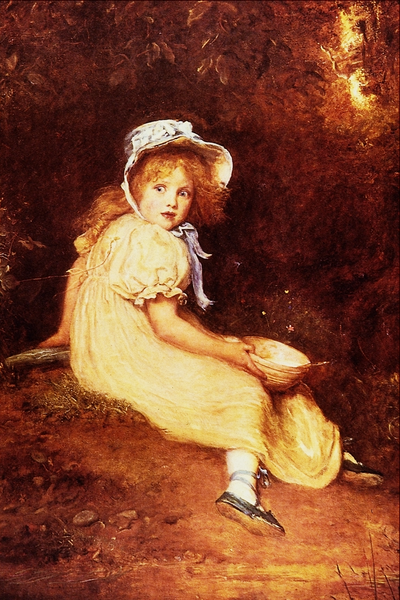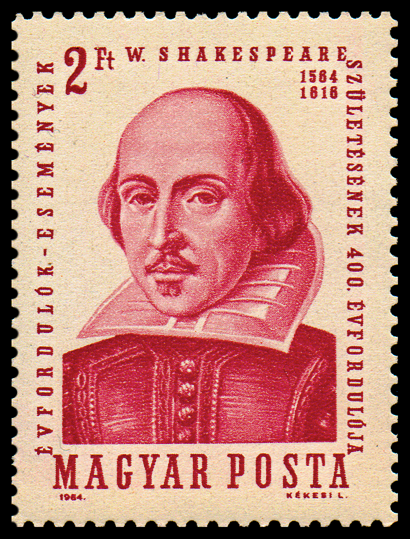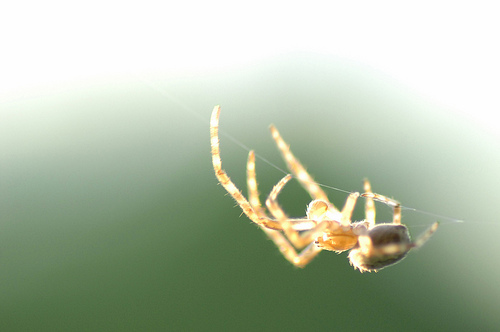
Source: Little Miss Muffet - Sir John Everett
Millais, John Everett Millais, Wikimedia
Little Miss Muffet
Little Miss Muffet,
Sat on a tuffet,
Eating her curds and whey;
Along came a spider,
Who sat down beside her,
And frightened Miss Muffet away.
If you think apostrophes are only used to punctuate, go “blank” when someone asks you to write free verse—or feel like telling poetry buffs to take a haiku—this section is for you. Right off, you’ll discover that “Death be not proud” by John Donne is also an apostrophe. You’ll also find out that Whitman wrote in free verse while Shakespeare wrote in blank verse. Review the three “R’s” of poetry terminology, rhyme, repetition, and rhythm, in a familiar nursery rhyme, “Little Miss Muffet.”
It stands to reason that rhyme can be found in nursery rhymes. “Muffet” and “tuffet” are obvious rhymes, whereas rhymes of “beside her” and “spider” are easier to hear than see. This nursery rhyme follows an AABCCB rhyme scheme. Miss Muffet’s name and its alliteration is repeated in the last line of this catchy verse. Another repetition occurs with the verb “sat”; both Miss Muffet and the uninvited spider “sat.”
Rhythm in poems, including “Little Miss Muffet,” is achieved by following a pattern of stressed and unstressed syllables called meter. The individual units of meter are called feet. These feet—unlike the 12” measure—come in various forms, such as the iamb, anapest, and dactyl. The most well-known of these is the iamb, which is an unaccented syllable followed by an accented syllable. Latin prefixes come in handy when you are counting iambs and other feet in poetry.
 If a line with one foot is called a monometer and a line with two feet a dimeter, then what is a line with three feet called? A line with four feet? Use your notes to record your answers. Then, check your understanding to see if you are correct.
If a line with one foot is called a monometer and a line with two feet a dimeter, then what is a line with three feet called? A line with four feet? Use your notes to record your answers. Then, check your understanding to see if you are correct. Sample Responses:
Trimeter – a line of poetry with three feet
Tetrameter – a line of poetry with four feet

Source: 1591 Design 200, Darjac, Wikimedia
A dactyl, which is an accented syllable followed by two unaccented syllables, is used in “Little Miss Muffet.” Most lines have two dactyls, but some are shortened. These short, predictable lines appeal to children and are easy to memorize. Jumping from nursery rhymes to the other end of the sophistication spectrum is the verse of William Shakespeare. The Bard wrote his plays in iambic pentameter, achieving a cadence more similar to natural speech, as in this description of the vehicle of the fairies’ midwife in Romeo and Juliet.
But soft, what light through yonder window breaks.
While dactyls and iambs are cool to know, it’s not necessary to memorize syllable types or study metrics to appreciate poetry. It’s more important to know that rhythm is one of the most important elements distinguishing poetry from prose.
Another important element of poetry that falls under the umbrella of figurative language is metaphor. When you use a metaphor to describe someone as “the light of your life,” you aren’t literally saying that that person is an incandescent or neon bulb. When you call someone “the apple of your eye,” you don’t really have a Granny Smith eyeball. Both are metaphors that show how much you value someone. Click on the link to watch Jane Hirshfield’s video “The art of metaphor.”
By creating lasting images, metaphors enable us to see things differently. Continuing with the theme of spiders, let’s examine the extended metaphor in Walt Whitman’s free verse poem “A Noiseless Patient Spider.”

Source: spider in the light, postbear, Flickr
A Noiseless Patient Spider
A noiseless, patient spider,
I mark’d, where, on a little promontory, it stood, isolated;
Mark’d how, to explore the vacant, vast surrounding,
It launch’d forth filament, filament, filament, out of itself;
Ever unreeling them—ever tirelessly speeding them.
And you, O my Soul, where you stand,
Surrounded, surrounded, in measureless oceans of space,
Ceaselessly musing, venturing, throwing,—seeking the spheres, to connect them;
Till the bridge you will need, be form’d—till the ductile anchor hold;
Till the gossamer thread you fling, catch somewhere, O my Soul.
Whitman creates a vivid image of a quiet spider spinning a web in a vast, isolated place. He personifies the spider, attributing to a lowly spider—considered loathsome by many—the human quality of patience. While conferring this quality seems complimentary, it isn’t spiders that Whitman cares about; he cares about people. He uses the spider as a metaphor for a soul or person. The poet uses the concrete image of spider to portray an abstract human emotion.
Like the solitary spider, human beings want to make connections. The spider’s action of forming a web is visible; one soul trying to find spiritual meaning or to connect with another is abstract and not as easy to describe. The spider and the soul are two very unlike things, but Whitman uses one to illuminate the other, opening up a range of interpretations. His metaphorical way of seeing things explains the desire to make spiritual connections difficult to describe in direct terms. Once the connection between the spider and the human soul is firmly established in the second stanza, the reader understands that the descriptive phrases about the fragile connections, once unique to the spider, like “ductile anchor” and “gossamer thread,” now apply to the human soul.
In Hirshfield’s terms, this poet’s metaphor shows us how to “know and feel things differently.” A door to our soul has been opened.

Source: Spider at Sunset, The-Tim, Flickr
In “A Noiseless Patient Spider,” Whitman makes abundant use of poetic devices, including alliteration and assonance. The spider explores a “vacant, vast surrounding” and launches “unreeling and speeding” filaments. “Measureless oceans of space” may have seemed like overstatement in 1891 when this poem was published, but now it seems like understatement given our modern discoveries about the universe. The mood of this poem is somewhat lonely and desperate, but at the same time, the spider’s determination is strangely hopeful.
Take a moment now to analyze the poetic elements in Whitman’s poem by answering the following multiple-choice questions.
- What poetic device does the poet use to emphasize ceaseless effort in the line “It launch’d forth filament, filament, filament, out of itself”?
- What technique is the poet using when he cries out in desperation and addresses his soul directly in the line “And you, O my Soul, where you stand”?
- Which element is missing from Whitman’s free verse?
Now that you have completed the section that discusses poetry terms, look at the list of terms found in this PDF. Use your software’s highlighter or other tool to mark the ones you need to review further.